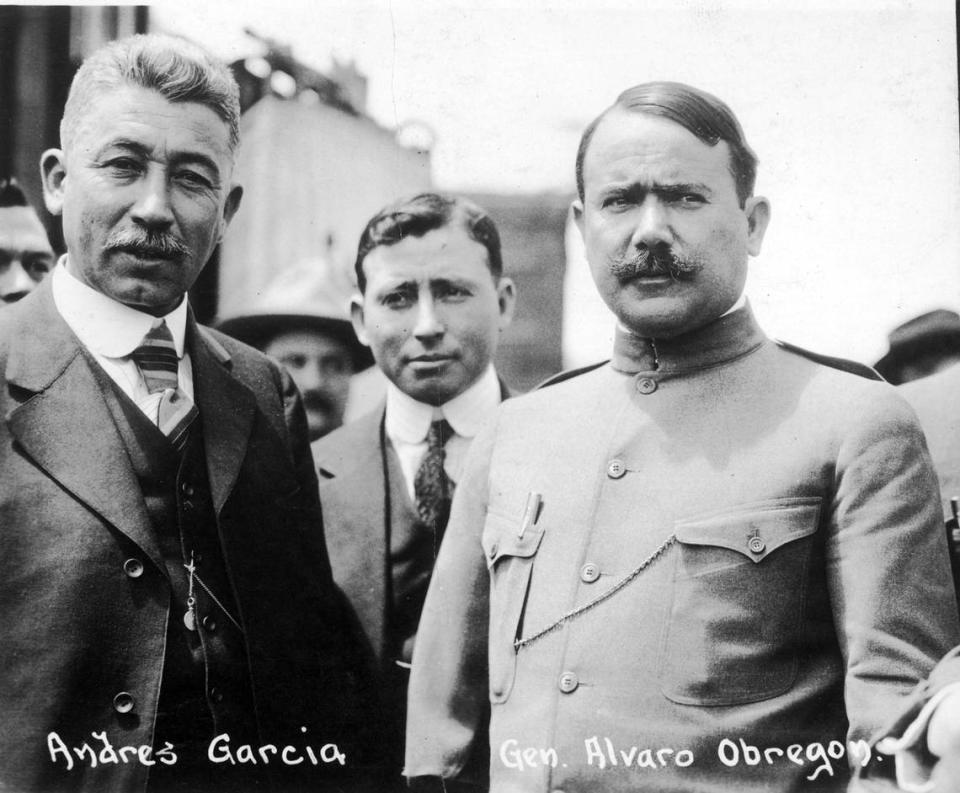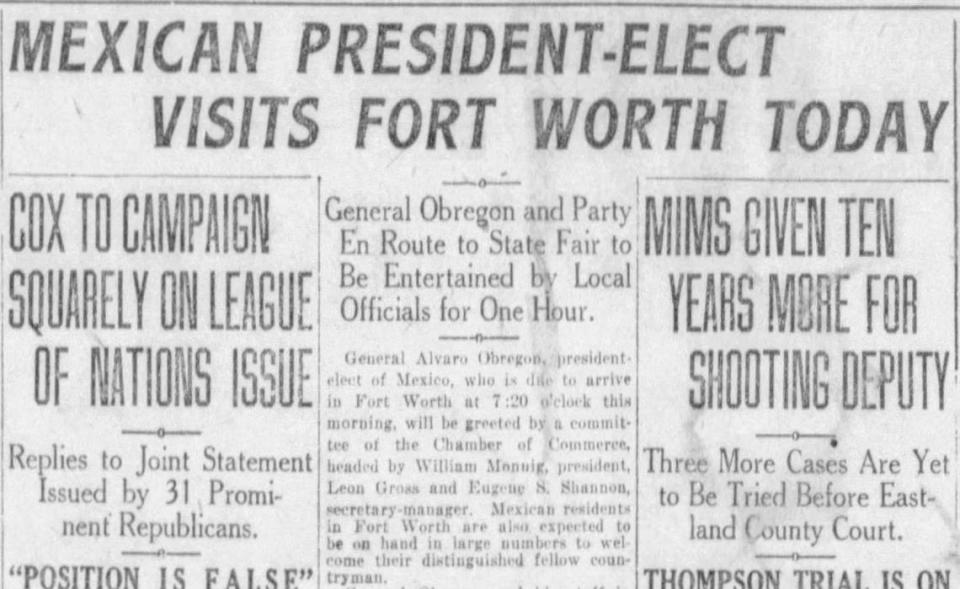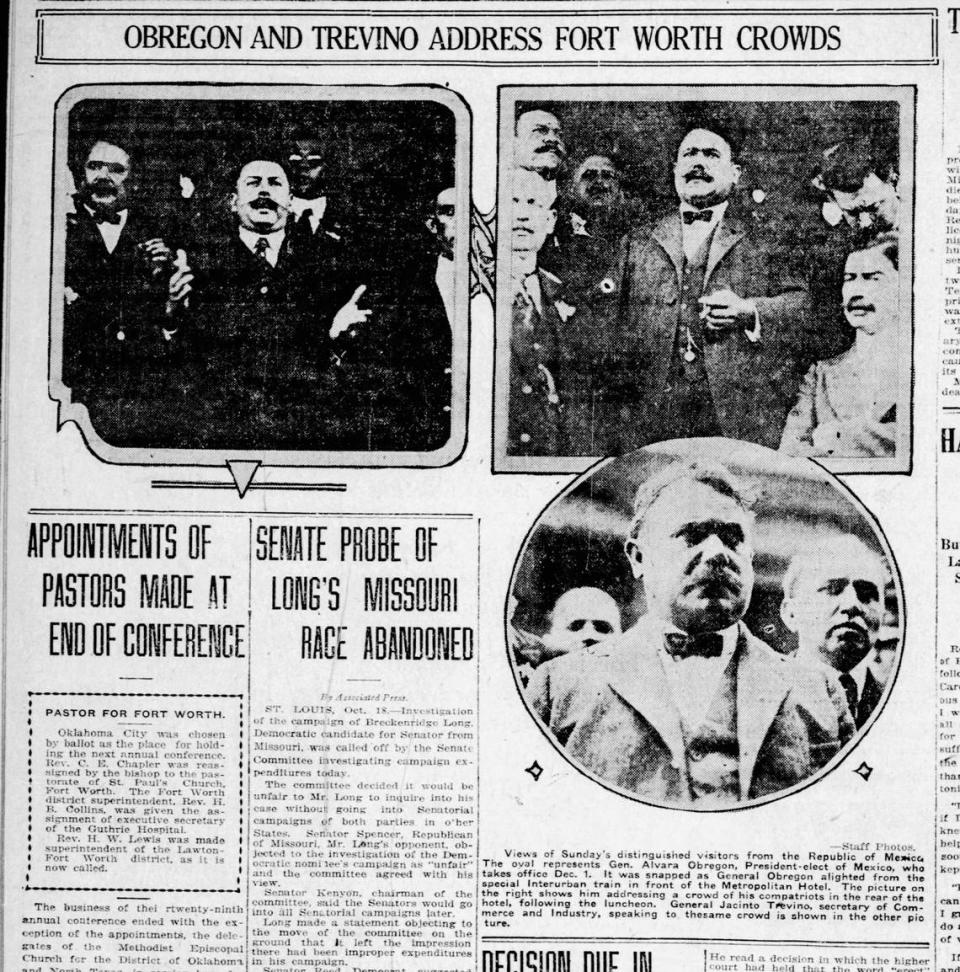In 1920, Fort Worth welcomed Mexico’s new president with open arms. But danger lurked.
- Oops!Something went wrong.Please try again later.
Dallas and Fort Worth mayors, chambers of commerce leaders, local Anglo and Latino citizens, and a municipal band waited eagerly at the Fort Worth T&P station on Oct. 16, 1920, at 7 a.m. for their special guest.
After the train pulled to a stop at 7:17 a.m., they searched the Pullman cars, only to discover Mexico’s president-elect, Álvaro Obregón, and his party had alighted, standing in the station sheds. Over 100 of Fort Worth’s Mexican residents patted him on the back and shouted, “Viva México!” “Viva Obregón!”
So began the newly elected Mexican president’s goodwill trip to North Texas for purposes of cultivating commercial and political relationships with the United States.

After 10 years of the Mexican Revolution, Mexicans were exhausted from deaths, economic ruin and governmental collapse. Obregón sought to convince the U.S. business community and government that his administration would bring peace, stability, education, democracy and jobs to Mexico. He welcomed investments and commercial trade that would profit Mexican and U.S. businesses.
Fort Worth and Dallas chamber leaders competed for Obregón’s time, aware the president-elect and his party were expected in Dallas on Oct. 16 to attend the 34th annual State Fair of Texas. For the first time, the State Fair declared Oct. 16 and 17 “International Days,” specifically tailored to their Mexican guests. Fort Worth chamber leaders invited Obregón to return the next day.
After the band played Mexican and U.S. national anthems, Obregón and his party got into cars with Dallas Mayor Frank Wozencraft and chamber leaders to drive to Dallas, where they were welcomed by Gov. William P. Hobby and more dignitaries at the Adolphus Hotel.

After breakfast, they motor-paraded with a police motorcycle escort to the State Fair where they heard the 117-piece Estado Mayor band from Mexico City strike lively tunes. Surrounded by police, plain-clothes detectives and Secret Service agents, Obregón and his host convened in the coliseum where warm greetings were exchanged to a large crowd including Mexican residents. Mexican Consul Roberto García praised the United States and encouraged fairgoers to witness the beauty and industry of Mexico as exemplified in their exhibit. It consisted of 12,500 pieces, costing $10 million.
The audience would have noticed the 40-year-old president-elect’s empty right sleeve. In the victorious Battle of Trinidad against Pancho Villa’s forces, Obregón lost it from an artillery strike, offering dramatic proof how the farmer-turned-revolutionary risked all for his country.
Mayor Wozencraft told Obregón there were now only two great soldiers, and those two had never suffered defeat: Gens. John Pershing and Obregón. After 10 years of shifting alliances, political intrigue and bloody fighting, Obregón emerged as the champion of the Mexican people.
However, enemies still lurked.
On Friday, Oct. 15, 1920, Consul Garcia informed Dallas Police Chief J.W. Ryan that he learned that two men had arrived from Los Angeles to assassinate Obregón. Ryan assigned bodyguards, set up security headquarters at the Adolphus, and directed detectives to find the culprits. When informed, a calm Obregón said, “If they are going to assassinate me, I would just as soon have it happen in Fort Worth as any place I know.”
On a car tour of Dallas, the party stopped at the “Mexican Park” on McKinney Avenue to allow Obregón to address 2,000 Mexican residents. To shouts of “Viva Obregón,” he encouraged his paisanos to return to the motherland and “make a great and powerful Mexico . . . We will no longer be forced to blush when we say we are Mexicans.”
The next morning, he returned to Fort Worth where he was honored with a luncheon at the Metropolitan Hotel. Toastmaster Louis J. Wortham compared their guest to Thomas Jefferson and Andrew Jackson. He added that Fort Worth considered their guests as citizens and neighbors. Obregón responded through an interpreter that their countries’ different religions and languages cannot act as barriers in a “true friendship.”
He later spoke to Fort Worth Mexican residents outside the hotel. Fort Worth detectives watched the crowds and Mexican neighborhoods for “suspicious characters.” Cowtown officials had sought to bring the Estado Mayor band to perform on the county courthouse grounds but were denied by State Fair officials based on contractual agreements.

After an auto tour of Swift & Co. meatpacking plants and neighborhoods, his Fort Worth hosts returned Obregón’s party to the T&P station to board the Sunshine Special bound for El Paso. The Special stopped in Ranger, where 2,500 residents — including 500 Mexicans — greeted Obregón and heard him give a 10-minute speech. In Mexico City, he laughed about the alleged assassination plot in North Texas.
After serving as president from 1920 to 1924, working to fulfill his promises for Mexico’s recovery and securing U.S. recognition of his government, he retired to his farm business in Sonora. He was elected president again in 1928, as a result of congressional repeal of term limits.
On July 17, 1928, Obregón was assassinated outside Mexico City by José León Toral, a zealot Catholic, because of the president’s anti-clerical role in Mexico’s Cristero War, 1926-1929. Some 90,000 Mexicans died in the religious conflict, and an estimated 250,000 fled to the United States.
Author Richard J. Gonzales writes and speaks about Fort Worth, national and international Latino history.

